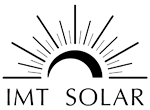1. Why should I use a PV reference cell instead of a pyranometer to monitor plane of array irradiance at my solar array?
A) The structure of IMT PV reference cells corresponds to that of a PV module; thus, the spectral sensitivity (spectral response, SR) and tilt error (incident angle modifier, IAM) of the reference cell are very comparable to the properties of PV modules. Pyranometers, on the other hand, behave very differently from PV modules due to their design with a dome and black receiver surface as the sensor element. These reference solar cells are therefore preferable as a reference for monitoring PV systems. Click here to read this NREL report for more information.
2. How long has IMT been manufacturing PV reference cells?
A) Our partners in Germany, IMT Technology GmbH (formerly known as Ingenieurbüro Mencke & Tegtmeyer GmbH), have been designing and manufacturing PV reference cells (also referred to as silicon irradiance sensors) since 1993. Because of our experience and a well thought out design process there are tens of thousands of our sensors installed around the world – including many from the earliest days of manufacturing.
3. How do IMT PV reference cells compare to their competition with regards to stability over time?
A) As all system owners are aware, sensor stability helps keep O&M costs low. A 2025 NREL report testing sensors from several manufacturers has IMT PV reference cells leading the pack in terms of stability and longevity, click here for full results.
4. What should be considered when installing a PV reference cell on a PV system?
A) Si sensors used for monitoring of PV installations must be installed with the same alignment and inclination (same plane) as the PV generator (solar panel). The mounting location should be free of shading as far as possible. To facilitate maintenance and cleaning of the Si-Sensor, the Si-Sensor should be mounted in an easily accessible place.
5. How accurate is the calibration of IMT’s reference cells?
A) The measurement uncertainty of the calibration of IMT Technology’s reference cells is 1.2%, making it the world leader in reference cells for PV monitoring. For Class A reference cells in accordance with IEC 61724-1:2021, a calibration measurement uncertainty of at least 2.0 % is required. Thanks to the extremely high reproducibility of IMT Technology’s calibration, different system locations can be excellently compared. And even after replacing sensors, you will continue to receive consistent measurement data on solar irradiance.
6. How do I measure reverse plane of array irradiance in a bifacial PV system?
A) According to various renewable energy labs, measurement of irradiance on the rear side is largely determined by the position of the sensor and can be difficult because the radiation varies greatly due to different reflection and shading. One option in accordance with IEC 61724-1:2021 is to mount the Si sensor directly on the PV substructure. This ensures that the sensor has the same orientation as the PV modules. The Si sensors from IMT Technology are very well suited for measuring irradiance on the rear side. Due to their high measurement accuracy and linearity, no extra calibration is necessary. Click here to read this NREL report for more information.
7. Can I extend or shorten the sensor cable?
A) Yes, the cable can be extended or shortened. When extending cables, be sure to use shielded cabling. For any RS485 sensors, twisted pair cabling (2 pair/4 conductor) is also a requirement. Consult the instruction manual for your sensor on the correct minimum conductor wire gauge needed for the length you intend to extend. Click here for a technical bulletin with further details.
8. Which RS485 to USB adapter can I use to configure my digital sensors?
A) In principle, any standards compliant adapter can be used here. We have had very good experiences with the ICPCON I-7561U (with galvanic isolation) or DIGITUS DA-70157 (without galvanic isolation).
